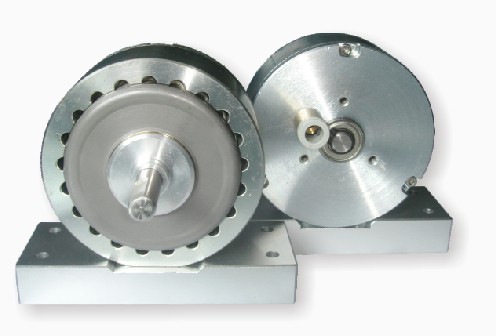In the fast-paced world of manufacturing, even the smallest inconsistency can ripple into costly delays, wasted materials, or compromised product quality. Enter **closed-loop tension control**—a technology that’s quietly revolutionizing industries from packaging to textiles, robotics to printing. But what makes it so transformative? Let’s dive into the mechanics, applications, and undeniable benefits of this unsung hero of industrial automation.
---
### The Heartbeat of Modern Manufacturing: What Is Closed-Loop Tension Control?
Imagine threading a needle while riding a rollercoaster. That’s essentially the challenge machines face when handling materials like film, wire, or fabric at high speeds. Open-loop systems, which rely on pre-set parameters without real-time adjustments, often fall short. They’re like driving a car blindfolded—eventually, you’ll veer off course.
Closed-loop tension control, however, acts as an autopilot. It uses sensors (load cells, dancers, or ultrasonic detectors) to continuously monitor tension levels, feeding data to a controller that dynamically adjusts motors, brakes, or clutches. This real-time feedback loop ensures consistent tension, even when speeds fluctuate or materials vary.
---
#### 🔍 Breaking Down the Components
1. **Sensors**: The system’s “eyes and ears,” detecting minute changes in force or position.
2. **Controller**: The “brain” that processes data and calculates adjustments.
3. **Actuators**: The “muscles” (e.g., servo motors) that execute commands to maintain optimal tension.
This synergy creates a self-correcting ecosystem, minimizing human intervention and maximizing reliability.
---
### Why Industries Are Racing to Adopt Closed-Loop Systems 🏭
The shift from open-loop to closed-loop isn’t just a tech upgrade—it’s a strategic move. Here’s why:
**1. Precision That Pays Off**

In label printing, a 2% tension error can misalign colors or tear delicate substrates. Closed-loop systems maintain tolerances as tight as ±0.5%, reducing scrap rates by up to 30%. For a factory producing 10 million labels daily, that’s millions saved annually.
**2. Adaptability in Action**
Consider a textile plant weaving mixed fabrics. A cotton-polyester blend behaves differently than pure silk. Closed- dynamometer , eliminating manual tweaks and downtime.
**3. Energy Efficiency**
By optimizing motor torque in real time, these systems cut energy consumption by 15–20%, aligning with global sustainability goals.
**4. Longer Machine Lifespan**
Irregular tension strains components. Consistent force distribution reduces wear and tear, slashing maintenance costs.
---
### Real-World Applications: Where Closed-Loop Tension Shines 🌟
**Packaging Industry**
Ever marveled at flawlessly wrapped chocolate bars? Closed-loop systems ensure films stay taut without stretching or wrinkling, even at 200 packages per minute.
**Wire and Cable Manufacturing**
A slack wire during insulation coating can lead to weak spots. Precise tension guarantees uniform thickness, critical for high-voltage cables.
**3D Printing**
In additive manufacturing, uneven filament feed causes layer gaps. Closed-loop control keeps extrusion rates steady, improving part strength and surface finish.
**Robotic Material Handling**
Robots assembling electronics need finesse. Too much tension? Components crack. Too little? Parts misalign. Closed-loop systems provide the Goldilocks zone of force.
---
### The Hidden Challenges (and How to Overcome Them) ⚙️

No technology is without hurdles. Implementing closed-loop tension control requires:
- **Sensor Calibration**: Misaligned sensors can “lie” to the controller. Regular maintenance is non-negotiable.
- **Algorithm Tuning**: A one-size-fits-all PID formula won’t work. Custom tuning for specific materials and speeds is essential.
- **Integration Costs**: Retrofitting old machinery can be pricey, but modular systems now offer scalable solutions.
Pro tip: Partner with vendors who provide live training and AI-driven diagnostics to smooth the transition.
---
### The Future: Smart Factories and Beyond 🔮
As Industry 4.0 matures, closed-loop tension systems are evolving into predictive tools. Imagine sensors that not only adjust tension but also predict material fatigue or schedule maintenance. Coupled with IoT, these systems could sync with ERP software, automating entire supply chains.
A beverage company, for instance, might use tension data to forecast film roll replacement times, ensuring zero downtime. The line between mechanical control and business intelligence is blurring—and closed-loop tech is at the forefront.
---
### Choosing the Right System: A Buyer’s Checklist ✅
1. **Scalability**: Can it grow with your production needs?
2. **Compatibility**: Does it integrate with existing PLCs or SCADA systems?
3. **Support**: Does the vendor offer 24/7 troubleshooting?
4. **Data Analytics**: Can it export performance metrics for ISO audits or AI training?
Don’t settle for a “black box” solution. Demand transparency and adaptability.
---
### Final Thoughts: The Silent Guardian of Quality 🌐
In an era where consumers demand perfection, closed-loop tension control isn’t a luxury—it’s a necessity. It’s the invisible hand ensuring your morning cereal box isn’t crumpled, your smartphone’s circuits are flawless, and your car’s airbag deploys without fail.
For forward-thinking manufacturers, investing in this technology isn’t just about solving today’s problems. It’s about future-proofing operations, building resilience, and staying ahead in a world where precision equals profit.
Ready to eliminate tension headaches—literally? The loop is waiting to close. 🎯
